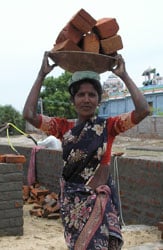Site will be
unavailable for maintenance from June. 4, 11:30 p.m., to June 5, 12:30 a.m. ET. Thank you for your
patience!
Education, Schools and Young Minds: India
Posted on 12/02/2005
By Kirsten Hongisto, communications manager-Asia for Christian Children's Fund
Ensuring that children returned to school became one of the major goals of Christian Children’s Fund following the tsunami of December 26, but the obstacles were immense.
The tsunami affected more than 120 schools in India. Others were closed to school activities and used as temporary shelters. In mid-January, schools in all but one affected district were able to open. However, attendance was low — sometimes only 30 percent of students showed up.
Reasons for this low attendance are probably as varied as the children themselves.
Some children were injured and unable to attend school. Unable to live in their devastated communities, other families relocated after the disaster. Some children came to school to escape the crowded shelters, but many parents were not ready to let their children leave their immediate care and kept them by their sides.
Child Centered Spaces
 |
| With the help of local residents in the cash-for-work programs, CCF is repairing and rebuilding schools in India. |
Because of the extra burden the tsunami placed on the formal education system in Tamil Nadu and Pondicherry, CCF-India opened 95 Child Centered Spaces that provided educational activities and psychosocial support to more than 16,000 children.
The children needed a safe place to go, with activities designed to meet their needs, and the Child Centered Spaces helped fill that gap.
What the Child Centered Spaces accomplished was powerful.
As one child said: “My name is Pramila. My father died in the tsunami. At that time, CCF-India had organized a Child Centered Space center in our village. Due to the kind and lovable behavior of the volunteers, I recovered from the feelings of the fearful tsunami.”
Child Centered Spaces are a crucial part of CCF’s immediate response in emergencies. They provide an opportunity for children to heal and grow through games, story telling, singing songs, dancing, basic math, art, writing and sports.
Seven months after the tsunami, CCF phased out its Child Centered Spaces as schools in India either reopened or ramped up their capacity to take on extra students.
CCF-India is refocusing its efforts by helping the Indian government provide high quality education opportunities for tsunami-affected children.
This has become one of CCF’s long-term objectives.
Before the tsunami, the education system in many parts of India lacked sufficient resources to meet the needs of the growing population. The government, however, made major strides in literacy during the 1990s — with school attendance growing from 52 percent to 65 percent during the decade.
Still, 20 percent of children aged 6 to 14 were not in school before the tsunami struck.
Enhancing Learning Opportunities for Children and Teachers
CCF’s effort to bolster public education is being done in two stages, thanks to support from CCF-Kinderhilfswerk and the British Department for International Development.
CCF is building 12 schools in the tsunami-affected areas, including:
- five primary schools in Nagapattinam;
- two primary schools and five preschools in Cuddalore.
Despite the heavy rainfall this monsoon season, the first schools should be completed in December 2005, with the remaining scheduled for completion by June 2006.
CCF is also repairing several tsunami-damaged schools in the region.
CCF will also train 80 teachers who will work in these schools in psychosocial support. Pre-primary and primary school teachers should come away with a heightened understanding of psychosocial issues and a greater ability to address these issues in the classroom and community.
Training includes:
- increasing teachers’ ability to support each other and connect with parents by working together in counseling support groups;
- equipping teachers with tools and skills to improve the well-being of primary school children by providing an empowering learning environment;
- increasing rural teachers’ and parents’ access to post-conflict counseling.
Loading...


